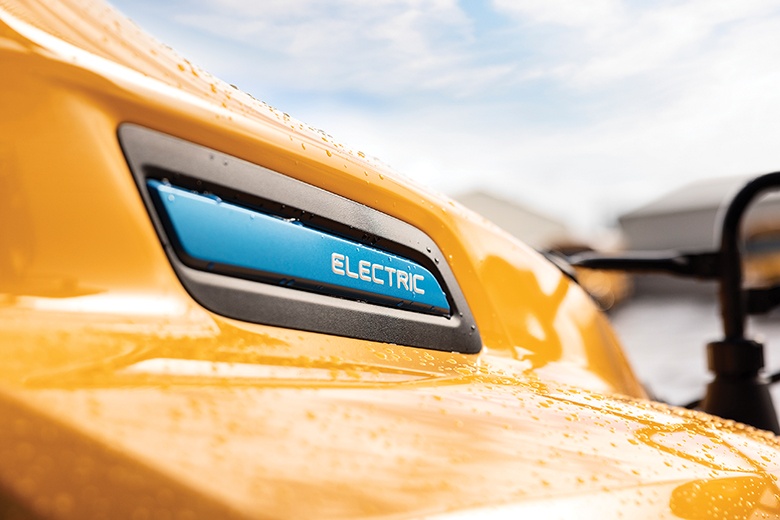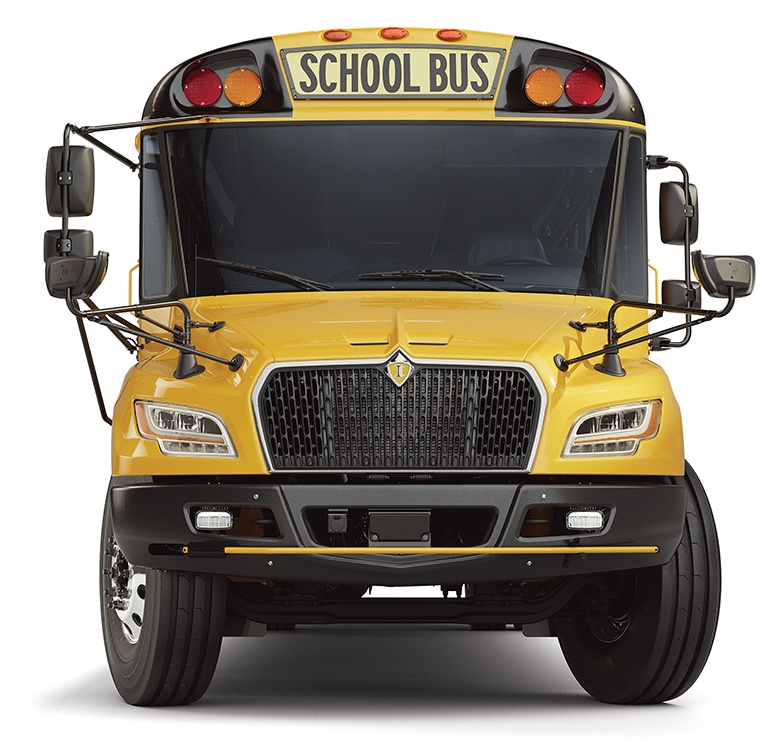
More Than ‘Just a Bus’
In July, IC Bus introduced not only their first product refresh in about 20 years, but shared a look into a strategy that will lead them into the future, focused on accelerating the impact of sustainable mobility and being an unparalleled partner of choice in the school bus industry.
The next generation of IC Bus is focused on what the OEM can do to help address the biggest issues facing our industry:
• Driver shortage & satisfaction
• Overall complexity & dynamic nature of the Transportation Director & Contractor’s role
• Parents’ confidence in their child’s school transportation
The Next Generation CE Series takes a best-in-class driver environment and takes it to a whole new level through enhanced accessibility, comfort and overall alertness – providing the driver with an increased level of confidence when sitting behind the wheel of a busload of students.
IC Bus has put efforts into providing holistic solutions beyond the vehicle, that help drive on-time performance and reduce operating costs…. helping the Transportation Director manage through those daily obstacles that love to pop-up and rear their head. Through an array of programs including extended warranties, an award-winning parts distribution network and service support, connected vehicle technologies – or bundled services (for example) to help a customer navigate the zero emissions transition – they realize no two customers are exactly the same – but through their vast network and capabilities, they are equipped to provide an unparalleled ownership experience.
Finally, whether its continuing to bring the latest and greatest safety technologies to vehicles keeping our students and drivers safe, educating communities on why school buses are the safest mode of transport to/from school, providing overall peace-of-mind with driving on-time performance, or their commitment towards zero emissions … IC Bus said it to help build parents’ confidence in their child’s school transportation.

Ahead of Its Class – The Next Generation CE Series
IC Bus took the next step toward full-industry electrification with the launch of the next-generation CE Series school bus.
The new CE Series introduces design innovations that improve driver comfort, safety, and total cost of ownership. The bus is available with a zero-emissions powertrain as well as a diesel option powered by the Cummins B6.7 engine.
Built with drivers in mind
The next-generation CE Series embodies their DriverFirst™ design philosophy. Justina Morosin, VP and GM of IC Bus, said driver feedback was a vital part of the vehicle’s development.
“We started the process by working with a pool of customers – observing drivers as well as our operators, and how they run their everyday business and routes,” she said. “Through that experience, we also noted what they struggle with, and what things are working great today. It truly was designed from their feedback.”
Driver comfort and ergonomics were imperative in the vehicle’s development process. The integrated dash HVAC system has improved driver controls, driver & rear-facing venting, enhanced defrost performance , and a blend-air system – allowing for better performance and optimized comfort for drivers and passengers.
“We felt so strongly about this design innovation that we made it a standard feature – one of the many reasons why this is a bus that drivers will want to be driving.’ said Katie Stok, Segment Marketing Director for IC Bus. “We went from a system that had minimal driver facing vents to now a fully integrated automotive-style driver experience with defrost now performing upwards of 50 percent better than the prior model. That’s huge, both for overall driver experience as well as safety.”

Seat options allow for a comfortable ride for all drivers, and the ingress/egress experience has been improved for all passengers.
The driver’s area now features a redesigned ergonomic wing instrument panel angled toward the driver with backlit controls that have driver-adjustable brightness, along with a new dash cluster that integrates the driver assistance safety features – such as Bendix Intellipark electronic park brake, collision avoidance, optional tire pressure monitoring system (TPMS), and more.
“The new CE Series has a redesigned, sloped hood that provides improved forward visibility, so drivers can now see 11 inches closer to the front of the vehicle,” Stok said. “From a driver attraction and retention standpoint, drivers are going to love this bus because it will help build their confidence in being able to succeed every day, doing their job and keeping our precious cargo safe.”
“We’ve taken what we feel was already the best driver compartment, to a whole new level,” Stok said. “Whether it’s seating options, accessibility to controls, enhanced visibility, or driver assistance safety features now integrated directly into the dash cluster to provide the utmost alertness, and the DriverFirst-designed driver compartment helps to heighten the drivers’ overall alertness and confidence in their ability to safely navigate a bus full of students day in and day out.”
Standard solutions like Navistar’s OnCommand® Connection (OCC) further enhance the driver experience by boosting uptime, as well as reduce total cost of ownership for fleet owners. OCC provides fault code reporting and severity ratings, vehicle health reports, fault code action plans that identify most likely needed parts and service, on-hand inventory of needed parts at the closest IC Bus dealer, and GPS mapping to nearby service centers. This is achieved through enhanced connectivity vehicle capabilities like providing fault code reporting and severity ratings, vehicle health reports, fault code action plans that identify most likely needed parts and service, vehicle track & trace, visibility to electric vehicle elements such as state of charge, charge history, estimated range and more. Up-to-date repair status updates are provided by IC Bus® 360, and the diesel models allow for over-the-air updates to Cummins engines.
For improved serviceability, the vehicle provides easier accessibility to those routine maintenance items, such as ethe stepwell heater and air dryer, as well as the HVAC, fuel, and oil filters. The availability of a Naviflex coated fuel tank, & bumpers, as well as treated interior modesty panels, and a one-piece driver floormat provide enhanced corrosion resistance.

OCC provides fault code reporting and severity ratings, vehicle health reports, fault code action plans that identify most likely needed parts and service, on-hand inventory of needed parts at the closest IC Bus dealer, and GPS mapping to nearby service centers.
Safety first
The vehicle’s increased visibility comes not only from the redesigned front end, but also from the new single glass panel entry doors.
Morosin said that safety was the top priority for IC Bus in developing both the electric and diesel models of the new CE Series bus.
“Everything we do at IC Bus, in terms of compliance, engineering, and testing, is very thorough,” she said. “That’s so important. With school bus electrification being the tip of the spear for the nation’s electrification, we are seeing many new OEMs and vendors enter this space. We love to see them become a part of this community and industry, but we must make sure safety is our number one priority.”
The new dash cluster includes a 5-inch digital color display with driver selectable views. The cluster is integrated with safety alerts for the driver, including door ajar alerts if the vehicle starts to drive and the doors are not fully latched or the optional tire pressure monitoring system (TPMS). The bus comes standard with daytime running headlights and a wide, non-tapered, evenly spaced stepwell with an optional dual height handrail that is accessible for passengers of all shapes and sizes. “We train our customers on delivery during deployment,” Morosin said. “We ensure all customers and dealers are trained for safety, along with all our technicians. Safety is number one.”
The drive toward electric
Because of student transportation’s repeatable morning and afternoon routes, IC Bus’s parent company Navistar sees school buses as the “tip of the spear” for electrification.
“Between the routes and what we’re finding from our school bus customers, it’s a perfect application for electrification,” Morosin said. “Districts are using Clean School Bus funding and buying one bus for a trial run. And they’re using the funding for the 19.2-kilowatt charger, which doesn’t require digging in the ground to power that bus.”
The electric bus has battery options of 210 kWh with 135-mile range or 315 kWh with 200+ mile range, with the powertrain operating at 255 kW / 342 horsepower at peak levels.
With both standard AC and fast DCFC charging, the CE Series also incorporates three levels of driver-selectable regenerative braking for maximum power savings and a smoother ride.
The bus represents a major part of Navistar’s push for 50 percent zero-emissions vehicle sales by 2030 and 100 percent by 2040. IC Bus also sees the vehicle helping to improve the transportation experience and general wellbeing of students from low-income communities, with 60 percent of U.S. students in low-income communities riding the bus to school compared to 45 percent of their peers.
“In areas designated as under-privileged or poor conditions, typically, the correlation that we see from our studies is that the emissions in those communities are not good,” Morosin said. “That’s harmful, as there is less ‘green’ air and more urban density. This is exactly why the EPA funding for clean buses is aimed at underprivileged communities in those socioeconomic areas.”
IC Bus’s dealer network will be integral to the rollout of the electric CE Series, with the company requiring each dealer to become certified to sell, service, and support the vehicle’s unique parts, infrastructure, and safety requirements. This certification will ensure that local dealer technicians can provide optimal operation and long-lasting vehicle life for communities of all sizes across the nation.
“Consultation with dealers and customers at the earliest stages is critical,” Morosin said. “We work with them to answer many questions regarding range, operating environments, and serviceability. It’s important for us to ask, ‘Is this good for you today, and how can we make this work, given your routes, and given your business and operations?’ We pride ourselves in doing that homework at the onset to ensure our customers have a successful journey transitioning towards electrification of their fleet.”
“Electrification is an ongoing journey, and we’re all learning,” she said.


